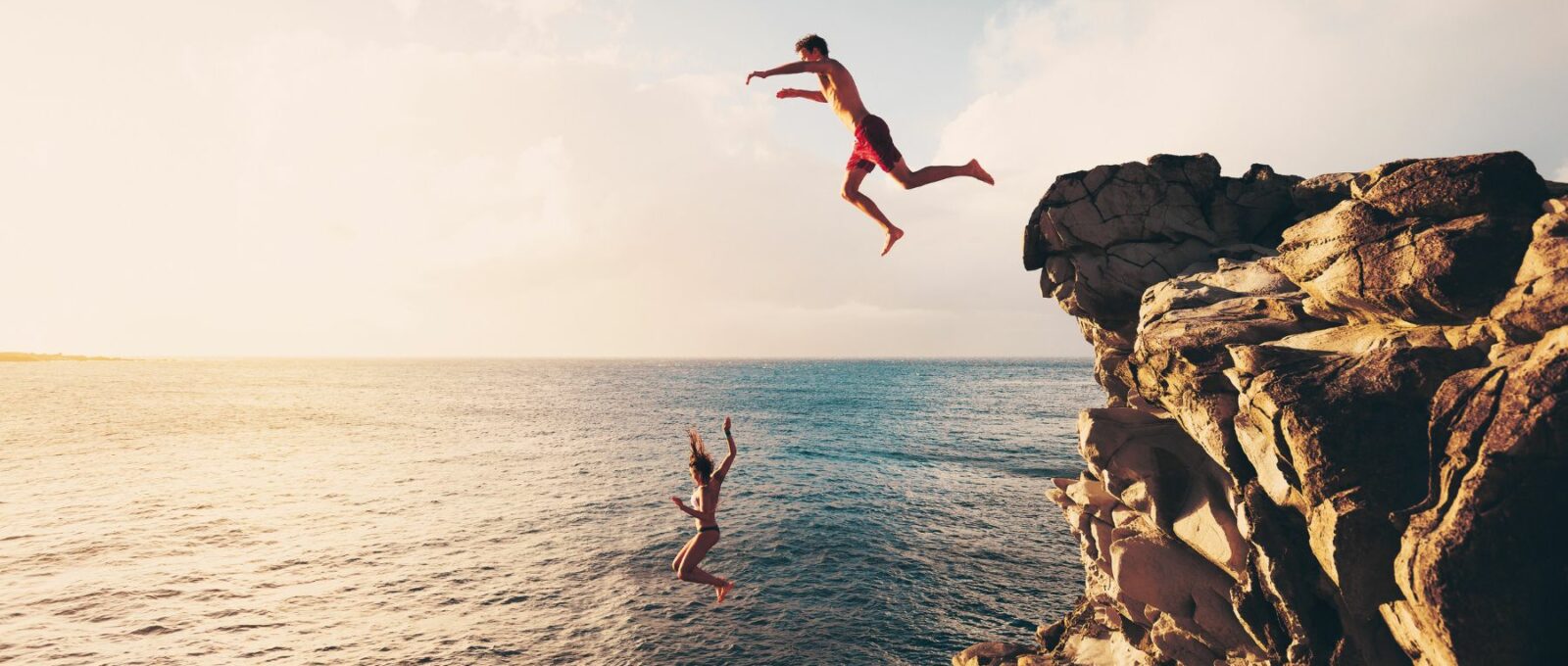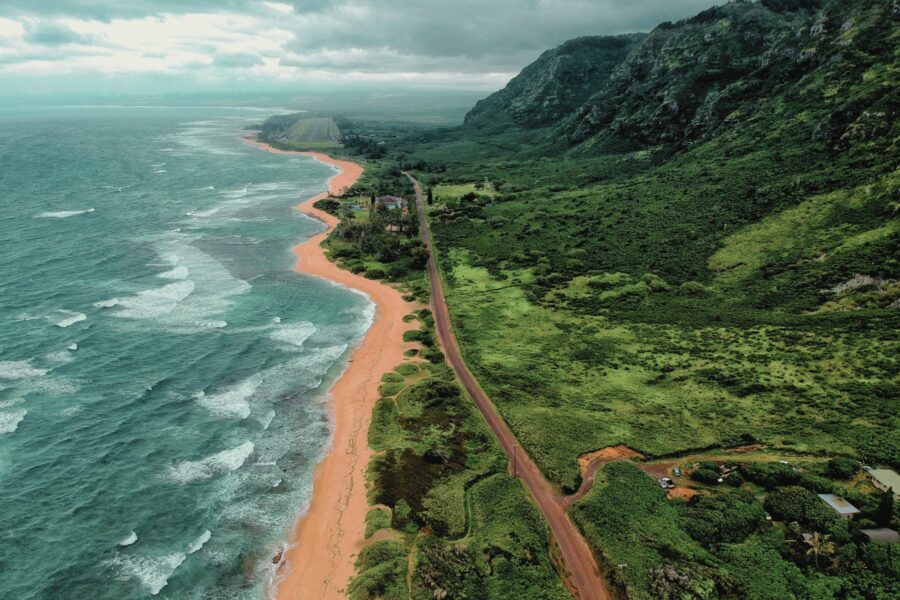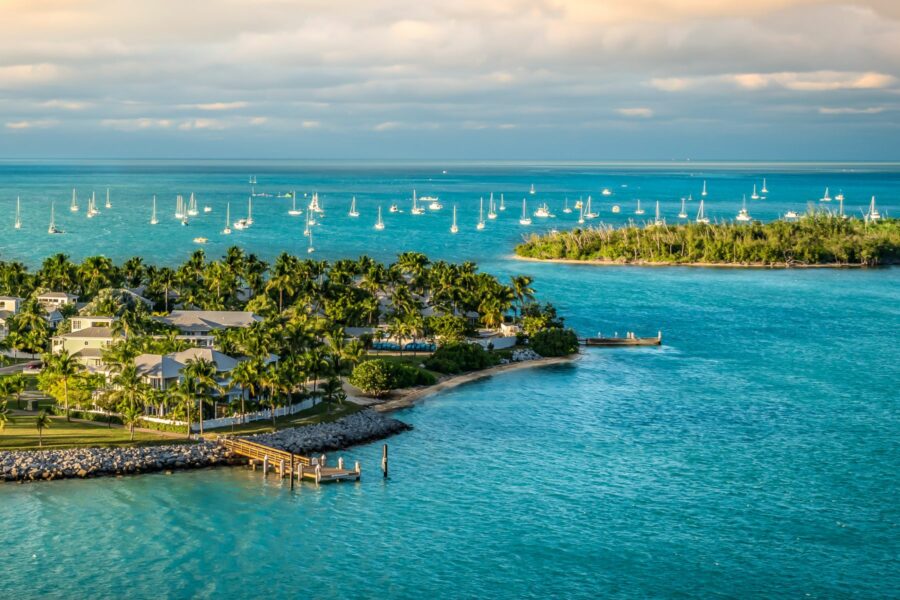Why is a family travel blog writing about Cliff Jumping in Oahu you ask?
My husband.
We’ve been to Hawaii quite a few times and seen every nook and cranny of the islands. So, my husband discovering cliff jumping was just a matter of time and now he’s hooked.
So here we are, nestled amidst the azure waters of the Pacific Ocean in the tropical paradise of Oahu that calls out to the adventure seekers from around the globe. While the island is renowned for its pristine beaches, lush rainforests, and iconic surf breaks, cliff jumping is a lesser known exhilarating activity that takes locals and visitors to new heights.
From the towering cliffs of the North Shore to the hidden gems along the Windward Coast, Oahu’s diverse topography provides a playground for those who dare to leap. We’ll take you on a journey into the heart of Oahu’s cliff jumping scene, where the boundless beauty of the island merges with the heart-pounding excitement of defying gravity.
But beyond the thrill of the plunge, cliff jumping in Oahu is an immersive encounter with the island’s natural wonders, granting you a new perspective on its rugged coastlines, marine life, and the untamed power of the Pacific Ocean.
Whether you’re an adrenaline junkie seeking the ultimate rush or a nature enthusiast searching for a unique encounter with Oahu’s untamed beauty, cliff jumping offers an unparalleled fusion of adventure and awe.
So, gear up and prepare to explore Oahu’s most breathtaking cliffs, where the thrill of the jump meets the beauty of paradise in an unforgettable dance between gravity and courage.
Where is Oahu?
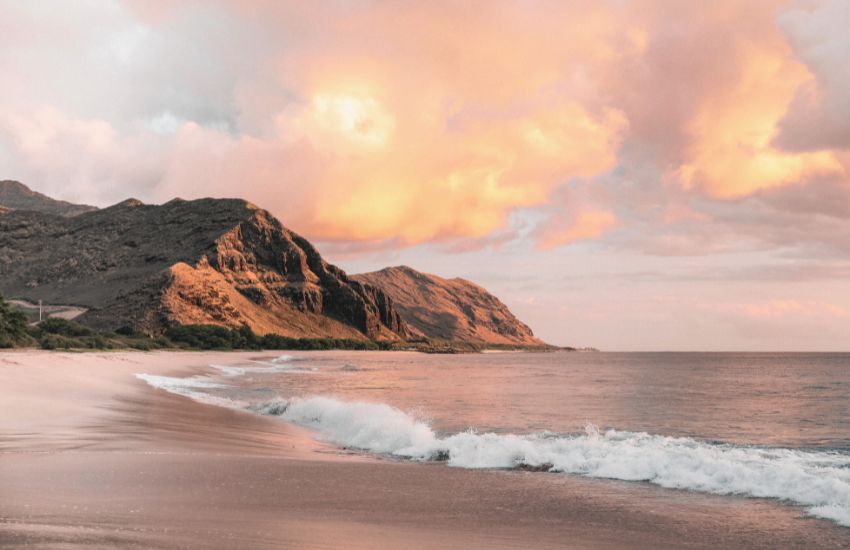
You’ll find Oahu in the state of Hawaii, approximately at 21.4389 N latitude and 158.0001 W longitude, with neighboring islands Molokai on its SE and Kauai in NW.
Planning a trip to Hawaii?
Read our Hawaii Destination Guides
Cheapest Island in Hawaii
Little Beach Maui – a Nudist Paradise
Hiking Kuliouou Ridge Trail in Oahu Hawaii
Lanikea Turtle Beach – Best times to visit
North Shore Oahu Hikes
What is Cliff Jumping?
With origins rooting back to Lanai, Hawaii, in the 1700s, King Kehekili did the first jump from the 100-foot Kaunolo cliffs. As most cliff jumpers would regard it, cliff jumping is a marriage of sports and art. As the name suggests, it’s literally jumping from a cliff. Sometimes, it’s also called tombstoning.
From simple jumps to creative ones where jumpers add elements like somersaults, tucks, and pikes, cliff jumping tests faith, courage, and plenty of spatial awareness. Whether it’s a first-timer or a competition for the pros, each leap of faith is no joke since there’s always the risk of serious injury.
It is often done for recreational purposes, such as thrill-seeking, adventure, or fun activities in natural settings like lakes, rivers, or coastal areas.
Cliff Jumping vs. Cliff Diving
Cliff jumping and cliff diving involves jumping or diving off cliffs into bodies of water, but they differ in technique and purpose.
Cliff jumping is generally just for fun. It can vary in height, ranging from relatively low cliffs to much higher ones, depending on the location and personal preference. Participants typically jump feet-first and may perform various acrobatic moves or tricks during the jump.
On the other hand, cliff diving is a more formal and competitive sport that involves diving off cliffs into the water. It often happens at organized events or competitions, where divers are judged on their technique, style, and execution of dives.
Cliff diving occurs from higher and more challenging platforms, such as specially designed structures or cliffs that meet specific safety criteria. Divers in cliff diving competitions perform a series of dives, including somersaults, twists, and other complex maneuvers, displaying grace, control, and precision in their movements.
It’s important to note that cliff jumping and cliff diving can be dangerous activities. Participants should always consider their own skill level, knowledge of the location, and safety precautions before engaging in either activity.
How high should a beginner cliff jump?

The height at which a beginner should cliff jump depends on several factors, including their physical abilities, swimming skills, and comfort level with heights.
Start with a low height of around 10 to 20 feet (3 to 6 meters). It can be a good starting point allowing you to get accustomed to the sensation of jumping from a height and learn proper technique. As you gain more experience and confidence, you can gradually increase the height of your cliff jumps. It’s essential to listen to your body and progress at a pace that feels comfortable to you.
Take the time to learn proper cliff jumping techniques. It includes jumping away from the cliff, keeping your body streamlined, and entering the water with your arms crossed in front of your chest. Learning these techniques can help reduce the risk of injury.
How old do you need to be to cliff jump?
The age requirement for cliff jumping depends on the location. Some locations will have clear rules and a recommended age limit while others won’t.
Cliff jumping is generally considered a doable activity for older children, at least eight years of age, for smaller jumps of around 1.5 meters.
Cliff jumping can be dangerous if you disregard proper precautions, such as assessing the water depth, avoiding hazardous areas, and ensuring adequate swimming skills. It’s important to note that younger kids may be more prone to injuries because of a lack of experience. Therefore, we highly recommend only doing it under adult/professional supervision and going for lower heights.
Going on a trip with Kids?
Take a look at these destinations
Key West with Kids
15 Things to do in Taylor Falls with Kids
18 Things to do in Northfield with Kids
25 Easy Hikes in the White Mountains
Best places for Cliff Jumping in Oahu
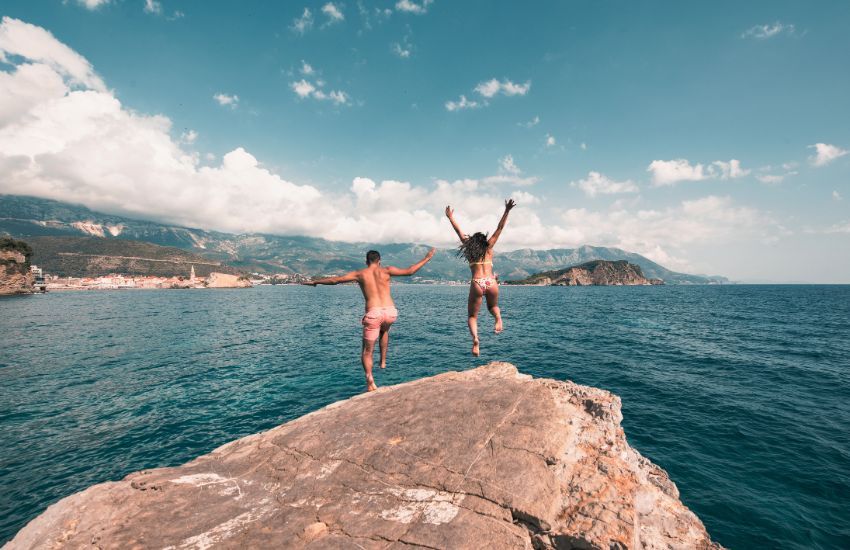
China Walls
- Lifeguard on duty: None
- Location: Portlock, Oahu
- Skill level/ Difficulty: Intermediate and Expert
- Height: 10-20 Feet
- Danger rating: Medium
- All tides: Yes
A popular spot for cliff jumping, Oahu, China Walls is a site for all-out fun. With 10-20-foot high jumps, jumpers with some experience and pros can enjoy the thrill here. The ledge is also spacious enough to accommodate everything you need for a day’s stay. Bonus, Spitting Caves is just nearby.
The height of China Walls is ideal for clocking in some somersaults on the way down and turns on the way down. However, the waves here are notorious for being powerful, solid riptides known for drawing some. You also need extra care on the way back up since the ledge has some sharp portions.
Kapena Falls
- Lifeguard on duty: None
- Location: Alpena Pool, Honolulu
- Skill level/ Difficulty: Expert
- Height: 30-40 Feet
- Danger rating: Difficult
- All tides: Check water depth before you jump
Sitting near the famous Nuuanu Memorial are the challenging cliffs of the 12-foot Kapena Falls. But before you get there, you must trek for 0.3 miles at the heart of the thick ravine that looks straight out of movies with jungle warfare. It’s a mesmerizing experience for thrill-seekers and nature lovers.
There are various jump points here, and the highest point is on the left side of the falls, dropping you from 40 feet. Remember, before you decide to jump, check for underwater debris and ensure that the water is high enough.
Laie Point
- Lifeguard on duty: None
- Location: Laie, North Shore
- Skill level/ Difficulty: Intermediate and Expert
- Height: 35-40 Feet
- Danger rating: Medium
- All tides: High Tide
If you’ve seen Forgetting Sara Marshall with Mila Kunis jumping into turquoise waters, this is that spot. Another epic cliff jumping Oahu site, you can test your bravery by jumping up to 40 feet high. Best to get your adrenaline kick during high tide to avoid hurting yourself. You must also be mindful of the strong waves and currents that frequent the area.
To find the jump point, you need to get near the left side of the ledge of the table rock across the white house. This way, you’re near the sharp rocks you need to climb to get back up. And yes, they are pretty sharp, so we recommend you wear grippy water shoes. The flat platform also makes it ideal to just spread your mat and spend the day enjoying the sun and catching the thrills of cliff jumping Oahu.
Mokes
- Lifeguard on duty: None
- Location: Na Mokulua Islands
- Skill level/ Difficulty: Intermediate and Expert
- Height: 15-60 Feet
- Danger rating: Medium to Extreme
- All tides: Questionable all the time
A pair of islands known as Moku Iki and Mohu Nui offers an excellent array of activities, from hiking to snorkeling and, of course, cliff jumping Oahu. Now, the bigger one, Moku Nui, is where you need to reach. To get there, you must rent a kayak and paddle for roughly half an hour from the shores of Kailua Beach or Lanikai Beach.
With numerous jump points, both jumpers with some experience and pros can enjoy the diversity of the heights, ranging from 15 to 60 feet. However, like most places for cliff jumping Oahu, you need to be careful of the current and check underwater first before anything else.
Waimano Falls
- Lifeguard on duty: None
- Location: Waimano
- Skill level/ Difficulty: Intermediate
- Height: 10-25 Feet
- Danger rating: Medium
- All tides: Summer is no-go
It will need a mile and a half long strenuous hike to get to the Waimano Falls, but once you do, you’ll be greeted with majestic falls and a few hanging ropes to assist in your jumps. You can choose at which height you would like to jump, which can go as high as 25 feet, which is ideal for intermediate cliff jumpers with some experience. It’s the perfect place to cool down after a challenging hike. Not to mention how beautiful the surroundings are!
On the other hand, it’s season-dependent. Summer frequently leaves Waimano Falls dry, so remember to stay updated with the current weather before you go. Otherwise, you’ll end up disappointed.
Waimea Bay Rocks
- Lifeguard on duty: Yes
- Location: Waimea Bay, North Shore
- Skill level/ Difficulty: Beginner to Expert
- Height: 10-35 Feet
- Danger rating: East to Medium
- All tides: Yes
Waimea Bay is famous as an excellent surfing spot, flocked by enthusiasts from all over the world. But more than its powerful swells, it’s also known to those who enjoy cliff jumping Oahu. With various jump points and clear turquoise waters, the Waimea Bay Rocks offer heights as low as 10 feet up to 35 feet. The sand-padded bottom also makes it ideal for scared beginners.
Now, when the surf’s up in winter, cliff jumping is not allowed since the current gets too powerful and dangerous. But if you’re around for the rest of the year, Waimea Bay is a lovely spot for some adrenaline rush. Also, keep your eyes peeled for turtles that often visit the shores. It’s easy to spot them anyways with the clear waters.
Once you climb the rock, there’s no backing away! You might get misfortune while going back down (at least according to the rumors of the rock’s curse). Climb, jump, and take a leap of faith.
MaunaWili Falls
- Lifeguard on duty: None
- Location: Kailua
- Skill level/ Difficulty: Intermediate and Expert
- Height: 30 Feet
- Danger rating: Medium
- All tides: Check water depth before you jump
You need skills as a hiker and cliff jumper to experience the thrill of MaunaWili Falls. You need to trek in a challenging 2-mile trail before you can reach the falls itself, and the jump height is also no joke, 35 feet.
Like most cliff jumping waterfalls, time your visit. You don’t want to put effort into the hike just to be met with a dried fall, especially in the summer. Remember to check any debris underwater and if the water is deep enough for a safe jump.
Traveling with Family?
Read our Family Travel Tips
25 Family Travel Tips to Slow Down
The Lightweight Family Vacation Packing List
Best Cliff Jumping Spots for Beginners
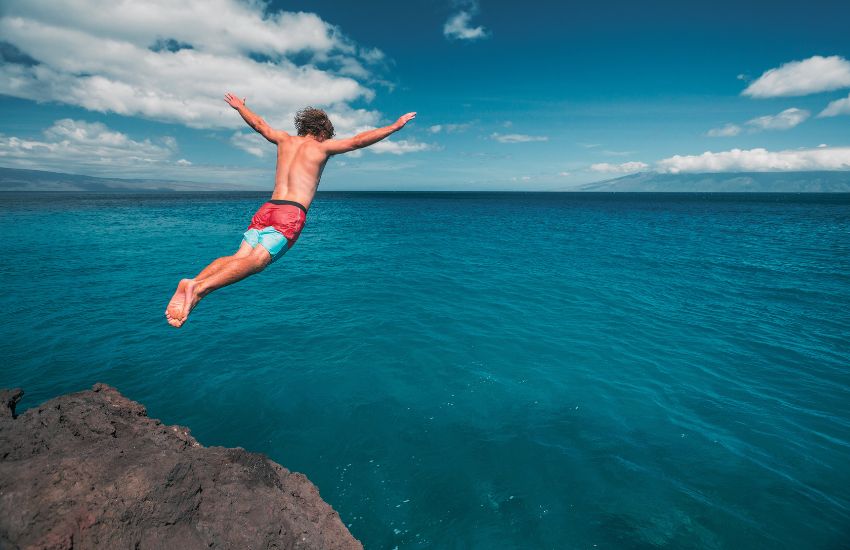
Alan Davis Plank Jump
- Lifeguard on duty: None
- Location: Kaiwi Shoreline Trail, Honolulu
- Skill level: Beginner to Experienced
- Height: 5 Feet
- Danger rating: Easy
- All tides: Yes
If you’ve never tried taking a leap of faith, the Alan Davis Plank in Kaiwi Shoreline Trail is the best cliff jumping Oahu experience. With only five feet high before impact, this place is ideal for first-timers and kids alike. The only caution you need to take is climbing back up through the rocks after your jump.
You can choose from a couple of planks and jump into the turquoise waters without problems. It’s popular with tourists and locals that coming here during weekends will likely irritate or amaze you (depending on your mood).
Considering Eloping?
Read about these beautiful destinations
Elope in Greece
Elope in Mexico
Elope in Iceland
Best Advanced Cliff Jumping spots

Leap of Faith
- Lifeguard on duty: None
- Location: Portlock
- Skill level/ Difficulty: Expert
- Height: 85 Feet
- Danger rating: Extreme
- All tides: Yes
For the experts and daredevils who want to try cliff jumping Oahu, the 85-foot high challenge of Leap of Faith lives up to its name. You need some next level of skills and bravery to test out this east-facing monster. And with powerful waves waiting on the point of impact, your swimming skills will also be tested.
If you’ve never tried jumps more than 60 feet, don’t even think about Leap of Faith. Remember to launch yourself far from the rock since plenty of other ledges are poking out, so you don’t get injured. Even experts don’t usually take jumps this high, so only attempt it if you have years of experience on your hat.
Spitting Caves
- Lifeguard on duty: None
- Location: Portlock
- Skill level/ Difficulty: Expert
- Height: 60-80 Feet
- Danger rating: Extreme
- All tides: Yes
One of the most dangerous spots for cliff jumping Oahu, Spitting Caves is known for its 60-foot drops and solid waves that backwash from the cave at the base of the ledge, creating a spitting effect. Mind you. It has taken several lives before, so only play around if you’re skilled enough. But if you’re one of the pros, it’s high enough to get a few somersaults before you hit the roaring waters. It’s also important to know where the rocks underwater are. No worries, you can ask other cliff jumpers or any local nearby.
After jumping, you can climb the rope on the right side or the ladder on the left. Spitting Caves is an epic spot for the experts but a death wish to fools who underestimate its savagery.
Nuuanu Reservoir Tower (Illegal – Not recommended)
- Lifeguard on duty: No
- Location: Nuuanu
- Skill level/ Difficulty: Expert
- Height: 70 Feet
- Danger rating: Extreme
- All tides: Check water depth before you jump
If you hear about this place we recommend you stay away. The Nuuanu Reservoir Tower is located on a fenced off private property. Going here means risking jail time.
It’s rare to see jumpers here at the 70-foot jump, but when they’re around, they surely have skills and daredevil descents.
Even if you are a professional this place is not recommended for cliff jumping due to its danger rating and the fact that entering means breaking the law and risking jail time.
Halona Blowhole
- Lifeguard on duty: None
- Location: Along Kalaniana’ole Highway, HWY 72
- Skill level/ Difficulty: Intermediate and Expert
- Height: 25-45 Feet
- Danger rating: Dangerous
- All tides: Yes
Not for the inexperienced and the faint of heart, Halona Blowhole is one of the most dangerous yet rewarding spots for cliff jumping Oahu. You can enjoy up to 45-foot-high jumps and perform a few combo tricks during your flight. The rock formations here are challenging to climb, and the strong currents known as Moloka’i Express are also staples in the area, dragging anyone and anything out and far. There are plenty of warning signs, but people couldn’t be bothered any less. Plenty of visitors still get near the ledges and test their luck.
Safety Tips for Cliff Jumping
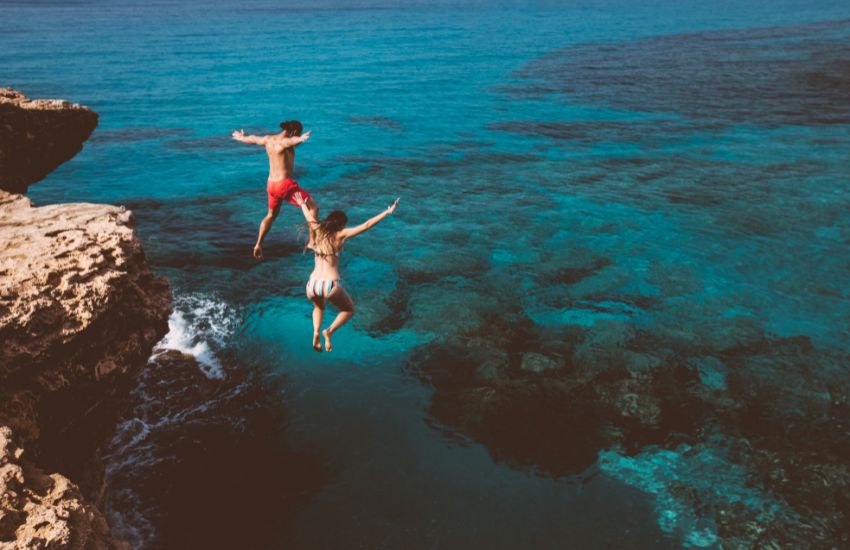
Cliff jumping can be an exhilarating and fun activity but carries certain risks. Here are some safety tips to consider before engaging in cliff jumping:
- Assess the area: Make sure the cliff jumping spot is suitable and safe. Look for deep enough water, free from rocks, submerged obstacles, or debris. Familiarize yourself with the area and potential hazards before jumping.
- Observe others: Take note of experienced jumpers and how they navigate the jump. Watch where they enter the water and how they resurface. It can provide valuable information about the safest jumping technique for that specific location.
- Know your abilities: Be honest with yourself about your swimming skills and physical abilities. Only attempt jumps that are within your capabilities. If you’re a beginner, start with lower jumps and progressively work up to higher ones.
- Check water depth: Ensure the water is deep enough to accommodate your jump. A general guideline is a minimum depth of 10-12 feet (3-4 meters). Shallow water can lead to severe injuries or even paralysis, so always verify the depth beforehand.
- Jumping technique: Maintain a streamlined body position and jump with your arms held tightly to your sides. Keep your legs together and avoid flailing or unnecessary movements. Land with your feet pointed downward to reduce the risk of injury.
- Look before you leap: Always check for obstacles, swimmers, or boats in the water before jumping. Make sure the landing area is clear and safe. Do not jump if there are any potential hazards in the way.
- Group supervision: Having at least one person acting as a spotter or lookout from a safe vantage point is advisable. This person can warn you of any dangers, incoming boats, or unexpected environmental changes.
- Follow local regulations: Respect any rules or regulations regarding cliff jumping in the area. Some locations may have specific guidelines or prohibit cliff jumping altogether. Adhere to these guidelines to ensure your safety and avoid legal issues.
- Don’t jump under the influence: Avoid cliff jumping while under the influence of alcohol or drugs. These substances will mess with your cognitive abilities and physical coordination, significantly increasing accident risk.
- Be aware of weather conditions: Double-check with the updated weather forecast. Avoid jumping during thunderstorms, heavy rains, or strong winds, as these conditions can be dangerous. Sudden weather changes can affect water conditions and visibility, so being prepared is essential.
Remember, cliff jumping is an adventure sport with inherent risks. It’s crucial to prioritize safety, assess the environment, and make responsible decisions to minimize the chances of injury.
So, step to the edge, take a deep breath, and leap into a world where the adrenaline rush meets paradise’s beauty. Oahu awaits, ready to unleash its breathtaking wonders upon those brave enough to seek them.
Jump safe!
Traveling with Family?
Read our Family Travel Tips
80+ Road Trip Snacks for Kids
Things to do on a car trip for a teenager
The Lightweight Family Beach Vacation Packing List
FAQs
Here are some of the beginner-friendly spots to experience cliff jumping Oahu:
– Waimea Bay Rocks
– Alan Davis Plank Jump
You can learn more about Oahu’s Best Cliff Jumping Spots in our guide.
If you’re an expert and want to feel all the rush, these spots will make cliff jumping Oahu even more exciting:
-Leap of Faith
-Spitting Caves
-Nuuanu Reservoir Tower (Illegal)
-Halona Blowhole
You can learn more about Oahu’s Best Cliff Jumping Spots in our guide.

